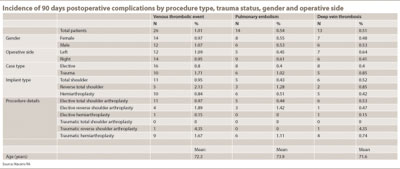VTE prophylaxis may be needed during traumatic shoulder arthroplasty procedures
Venous thromboembolism prophylaxis may be necessary after traumatic shoulder arthroplasty, according to a study conducted by shoulder specialists at Southern California Permanente Medical Group.
The study will be presented at the 2011 Congress of the European Society for Surgery of the Shoulder and the Elbow in Lyon, France.
Ronald A. Navarro, MD, and colleagues wanted to find out if patients should be given prophylactic anticoagulants after shoulder arthroplasty to prevent venous thromboembolism (VTE).
“The risk of DVT or PE [pulmonary embolism] may far outweigh the effects of anticoagulants in some shoulder arthroplasty subsets,” Navarro said.
Navarro and his team began their study to “see if the effect of traumatic indication, meaning arthroplasties that were done because of trauma, would have a higher incidence of symptomatic VTE,” which would necessitate the use of anticoagulants postoperatively.

Inclusion criteria
The researchers conducted a retrospective study of 2,574 patients, with a mean age of 72.3 years, who underwent shoulder arthroplasties between 2005 and 2009. They excluded patients who had a previous history of a VTE or anticoagulant use. Inclusion criteria were patients who had elective or traumatic total, hemi- or reverse shoulder arthroplasties.
The investigators used an ICD-9-CM algorithm to screen for 90-day symptomatic postoperative VTE events. They also reviewed postoperative anticoagulant use, radiographs, ultrasounds and patient charts to find VTE events.
Higher incidence of VTE
The overall incidence of VTE in the 2,574 arthroplasties was 1.01%. There was no statistically significant difference by year, gender or operative side. The major finding of note, according to Navarro, was that the rate of VTE in trauma patients doubled that of elective patients. In the 586 trauma patients it was 1.71%, compared to 0.8% in the 1,988 elective patients.
In assessing only elective cases, reverse shoulder arthroplasty patients had a higher rate of VTEs at 1.89% compared to total shoulder arthroplasties at 0.97% and hemiarthroplaties at 0.15%. Similarly, elective reverse shoulder arthroplasties had a higher incidence of PE than elective hemiarthroplasty or total arthroplasty. No significant difference in the rate of deep venous thrombosis was found when comparing the three elective groups. The traumatic hemiarthroplasty group had a higher incidence of VTE and PE than elective hemiarthroplasty group.
“Overall, VTE incidence was low in the entire study population,” Navarro said. “Should you prophylax a shoulder arthroplasty with anticoagulants just like we do in total hip and knee replacements, right after you do the surgery? If it is a traumatic indication, maybe we should. Postoperative VTE prophylaxis can be supported in traumatic hemiarthroplasty and in reverse shoulder arthroplasty patients, as this data suggests higher VTE incidence in both of these subset populations.”
Navarro wants to further study the populations as his group’s shoulder registry increases enrollment to see if the trends continue.
“If we keep finding the same things, [then] we would suggest more strongly the need for VTE prophylaxis in those populations,” Navarro said. – by Renee Blisard
Reference:
- Navarro RA, Inacio MCS, Burke MF, et al. Effect of traumatic indication and implant type on symptomatic VTE rates in shoulder arthroplasty. Scheduled to be presented at the 2011 Congress of the European Society of the Shoulder and the Elbow. Sept. 14-17. Lyon, France.

- Ronald A. Navarro, MD, can be reached at the Department of Orthopedic Surgery, Kaiser Permanente – South Bay, 25825 S. Vermont Ave., Harbor City, CA 90710; email: ronald.a.navarro@kp.org.
- Disclosure: Navarro and his co-authors have no relevant financial disclosures.
![]()
|
|
It would be useful to understand the frequency of lower extremity trauma or other surgery performed in patients having prosthetic management of a proximal humeral fracture. Were these polytrauma cases? Were they in the hospital longer (length of stay analysis as a comorbidity factor) or recumbent for a longer period of time? Most patients with reverse total shoulder arthroplasty (TSA) are a decade older with more comorbidities than patients who have anatomic TSA or a hemiarthroplasty (HA). It may not be the nature of the type of shoulder replacement, but rather, the nature of the patient population. This is important to consider as the risk stratification to anticoagulate would be focused on patient characteristics rather than what type of prosthetic was placed.
The study performed is useful in that is represents a large population of patients in a captured health care environment allowing for accurate and comprehensive data collection of this population after surgery. It, therefore, provides some important baseline information of the frequency of VTE in this population. It does not, unfortunately, separate out patient risk factors from the type of surgery performed. I am assuming that the body of this paper does not address this data and that the abstract reflects the entire content of the paper.
— Joseph Iannotti, MD, PhD
Orthopedics Today Shoulder & Elbow Section
Editor
The Cleveland Clinic
Cleveland
Disclosure: Iannotti has
no relevant financial disclosures.

